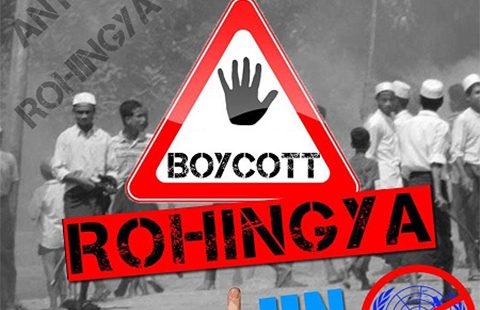Robert Talcoth examines how competing narratives on the the Rohingya and human trafficking clash in Thai and Myanmar social media.
On 1 May Thai authorities found the bodies of 26 migrants in a detention camp in the jungles of Songkhla province, near the border with Malaysia.
The victims, believed to be Rohingya refugees from Myanmar and Bangladesh, had been held captive by human traffickers in the jungle. The camp served as a transit point where illegal migrants were held before being sold or shipped to other destinations in Southeast Asia.
Thailand has long served as a centre for human trafficking groups operating in Southeast Asia. Groups of people from neighboring countries come to Thailand to find work in factories, construction or the booming sex industry. But many also come to escape violence and persecution in their homeland. Human trafficking in the region has increased in recent years due to ethnic conflicts between Buddhists and the Rohingya Muslim minority in Myanmar’s Rakhine state. Thousands of ethnic Rohingya Muslim’s have left Myanmar to escape violence and persecution.
Human trafficking and the trail of broken people
The Rohingya, considered to be one of the largest groups of stateless peoples in the world, have suffered decades of discrimination and injustice in Myanmar. The Myanmar government has since independence in 1948 refused to acknowledge the Rohingya as one of the nation’s indigenous ethnic groups. The roughly one million Rohingya living in Myanmar have no citizenship and their legal rights are limited. The Myanmar government classifies them as intruders that have illegally entered Myanmar from Bangladesh.
The Rohingya claim to have a historical connection to Rakhine state in western Myanmar, where the majority of them still live. This claim is backed up by some scholars. Certain groups of Rohingya can trace their ancestry back to pre-colonial kingdoms in the region; others came to present day Myanmar from Bengal during the colonial era in the mid-1800s. When ethnic violence in Rakhine state intensified in 2012, large numbers of Rohingya fled Myanmar. Human Rights Watch accuses the Myanmar authorities of actively supporting and at times taking part in ethnic violence aimed at the Rohingya minority. The objective of the attacks appears to be to drive the Rohingya out of Myanmar.
Human traffickers have capitalised on the suffering and desperation of these refugees. The traffickers have received large sums of money to bring Rohingya Muslims from Myanmar to different destinations in Southeast Asia.
However, the Rohingya’s problems often do not end after leaving Myanmar. Once out of the country they can find themselves in the hands of human trafficking gangs whom in many cases do not fulfill their end of the bargain. According to several reports, human traffickers have held people hostage and demanded ransom money from their families, instead of delivering them to their promised destinations. In many cases the gangs have murdered the hostages after receiving money.
During the last couple of months Thai and Malaysian authorities have discovered several detention camps and mass graves in the deep jungles along the Thai-Malaysian border. People being held in these camps have been forced to live under horrible conditions. Survivors have given reports of regular beatings, rape and threats. Activists believe that there still could be more than 60 camps within the Thai-Malaysia border area. The majority of refugees found in the camps have paid traffickers to bring them out of Myanmar, but some survivors claimed to have been kidnapped from their hometown and held hostage by traffickers.
The discovery of the detention camps and mass graves came during a time when Thailand was already under pressure from the international community for not addressing human trafficking problems in the region. Detailed reports describing exploitation and violence against migrant workers in Thailand have received growing international attention. Human rights organisations have accused Thai authorities of being involved in human trafficking and profiting from the exploitation of migrant workers.
As a result of the government’s unwillingness to seriously address human trafficking issues, Thailand was downgraded to a tier 3 ranking, the lowest, on the human trafficking index in 2014. This placed the country in the same category as North Korea and Saudi Arabia.
There has been particular focus placed on the treatment of migrant workers in Thailand’s multimillion dollar fishing industry. Detailed reports on the horrific conditions of migrant workers, mainly from Myanmar and Cambodia, in Thailand’s fishing industry have been published in the international press. The reports state that the Thai fishing industry is partially built on slavery and systematic exploitation of migrant workers. In many cases migrant workers had paid middlemen to be taken to Thailand and start working in factories, but instead of the promised factory work they were sold to fishing boats where they were forced to work under slave like conditions.

Picture from a campaign by American NGO Environmental Justice Foundation (EJF).
A large number of workers on Thai fishing boats claimed to have been forced to work 20-hour shifts while receiving beatings by their superiors and earning practically nothing. The workers were in some cases only fed one meal per day and those that got sick or were unable to work were sometimes even thrown overboard. A 2014 report from Reuters detailing the persecution and trafficking of the Rohingya in Southeast Asia showed that Thai authorities do not only turn a blind eye to human trafficking and abuse, government officials are also often directly linked to human trafficking rings whom exploit migrant workers in the region.
The European Union has taken a clear stance against fishing products coming from unlawful practices, such as the usage of forced labor and fishing methods that harm the environment. Thailand’s failure to act on a number of issues related to the country’s fishing industry has led the EU to threaten a ban on seafood imports from Thailand. If Thailand doesn’t show improvement within a certain timeframe a ban might come into place. This is an issue that the Thai government is currently dealing with. A large amount of the county’s fishing boats are presently not allowed to leave harbour due to the lack of proper documents and failure to follow regulations.
The Thai military junta has tried to divert attention away from human trafficking s and they have on a number of occasions publicly warned local journalists not to write about its presence in Thailand and especially trafficking related to the fishing industry.
Silencing the media
When two local Thai journalists cited parts of a Reuter’s report that linked the Thai Navy to human trafficking networks they were arrested by police and charged with defamation. The case is still ongoing and the two journalists could face several years in prison if convicted.
In another case, a journalist from Channel 3 who reported on the conditions of workers in the Thai fishing industry was summoned by the military junta. In his television show ‘Bringing back happiness to the people’, General Prayuth Chan-ocha criticised the Thai media for writing negative things about Thailand and the government. He stated that anyone that loves the country should not write anything negative, and he wondered if the journalists that had published information about human trafficking and the fishing industry were really Thai.
The two separate incidents , can be viewed as attempts by the government to intimidate journalists and stop them from writing about the issue. It is clear that the military regime does not want the people to have access to information that details the hardship imposed on migrant workers and the corruption related to trafficking of people. The message sent out is that whoever brings up this issue will face consequences.
The prospects of losing hundreds of millions of baht as a result of the European Union’s potential ban on Thai fishing imports have forced the government to seriously address fishing practices and human trafficking. When it became clear that authorities were actually going to crackdown on human trafficking the trafficking gangs started to panic and illegal migrants kept in camps in the jungle and onboard boats in the sea were abandoned and left to fend for themselves.

Picture from the Facebook page of Songkla province’s Rohingya support group (р╣Ар╕Др╕гр╕╖р╕нр╕Вр╣Ир╕▓р╕вр╕Кр╣Ир╕зр╕вр╣Ар╕лр╕ер╕╖р╕нр╣Вр╕гр╕ор╕┤р╕Зр╕вр╕▓р╕Ир╕▒р╕Зр╕лр╕зр╕▒р╕Фр╕кр╕Зр╕Вр╕ер╕▓).
Pushing back the boats
In May thousands of Rohingya and other migrants were bounced around the region’s seas as Australia, Indonesia, Malaysia and Thailand pushed back their boats. Many had fled persecution and poverty in Myanmar.
Thai authorities refused to allow the refugees to enter Thailand on the grounds that they lacked sufficient resources to take care of them. This sparked a wave of criticism from the international community who argued that the Southeast Asian nations have a common responsibility to address the humanitarian disaster.
As the issue received increasing attention in Thai media it also took centre stage on Thai social media. Some commentators criticised the government’s decision to turn away the refugees, but the most vocal group on social media supported it.
In the midst of the refugee crisis American Secretary of State John Kerry spoke to the Thai government about the possibility of Thailand providing temporary shelter for the Rohingya. This was interpreted by Thai netizens as an attempt by the US to pressure Thailand into sheltering the Rohingya boat refugees, and it sparked an outrage on Thai social media.
The US, which already had a tense relationship with the Thai government and its supporters after criticising the 2014 military coup, was accused of once again meddling in Thailand’s internal affairs. Thai netizens argued that if the US is so concerned about the welfare of the Rohingya they should take care of them and let them go to America.

Social media: telling or distorting the truth?
The vast majority of social media commentators appeared to support the Thai government’s initial decision not to let the Rohingya enter Thailand. The most common arguments were that Thailand already has enough problems of its own and that the refugees would be a financial burden. Many social media users also argued that the refugee crisis does not concern Thailand and therefore the country has no responsibility to assist them.
Since the Rohingya issue was brought into the spotlight a number of opposing narratives have appeared on social media. By following the different Facebook threads related to this issue it becomes clear that social media users face a situation where it becomes increasingly difficult to differentiate between fact and fiction.
The Bangkok Post has posted several articles about the Rohingya on their Facebook page. Each story has received a large amount of comments. Many of the comments were made by Facebook users from Myanmar, which is quite uncommon since the newspaper focuses on Thailand and the majority of its readers are either Thai or expats living in Thailand. By looking at the comments made by Facebook users from Myanmar it becomes clear that a majority of them believe that the international media has reported lies and distorted facts about the Rohingya and the situation in Rakhine state.
Their posts reflect the Myanmar government’s version of the story, which labels the Rohingya as illegal migrants from Bangladesh. The ethnic violence in Rakhine state is explained as being caused by Rohingya Muslim aggression towards Buddhists. In these threads, the Rohingya, at times referred to as “Bengali scum” or other derogatory terms, are frequently accused of being violent, lazy, of having too many children, and even of having links to international Muslim terrorist organisations. Several users have posted links to articles that portray the Rohingya in a negative light and images of what appears to be Rohingya committing crimes and behaving violently. In this narrative the Rohingya are not the victims, they are the aggressors.


Images of Buddhist statues and shrines claimed to have been destroyed by the Rohingya.
Many Thai social media users commenting on the issue have come to accept the Myanmar government and their supporter’s version of the situation concerning the Rohingya and the conflict in Rakhine state. This is interesting considering Thailand’s history of hostility towards Myanmar. In both Thai nationalist discourse and popular culture, Myanmar is often depicted as the nation’s enemy, but on this particular issue large numbers of Thais are rigorously defending its neighbour. The Thai narrative closely follows that of Myanmar; the Rohingya are not from Southeast Asia, they are from Bangladesh, and the conflict in Rakhine state was sparked by Muslim Rohingya terrorising Buddhist communities. This narrative contradicts independent reports on the situation in Rakhine state. Nevertheless, Thai social media users have to a large extent adopted the idea of the Rohingya as dangerous Muslims and there exists a fear that the Rohingya will harm Thai people and cause problems if they are allowed into the country.

Image shared on social media. The text reads “The majority of Thais don’t want the Rohingya in Thailand”.
There are even some groups that believe that the Rohingya are linked to international Muslim Jihadist groups and that they want to enter Thailand so that they can join the Muslim insurgency in Thailand’s three southern provinces. There is off course no evidence linking the Rohingya to Muslim insurgents in the South. The fear and hatred of the Rohingya based on their religious beliefs is to some extent shared by groups of Thailand’s expat community. Expats commenting on the issue often make groundless links between Islam and violence, the argument being that, the Rohingya are Muslims and Muslims will cause problems. Within the expat community one can find traces of ignorant Islamophobic sentiments that have spread throughout Europe and America in recent years.

Stop! Don’t let the Rohingya enter our country. We don’t want the Rohingya!
When reports about ethnic cleansing and violence against the Rohingya in Rakhine state are brought up on social media, people that are against the idea of helping the Rohingya are quick to claim that the reports are made up of lies and fabrications spread by Western media, who are also accused of distorting facts in order to damage the international reputation of Myanmar, Thailand and Southeast Asia in general. The criticism of Western media, its portrayal of Myanmar, and the refugee crisis contains anti-Western and anti-colonial rhetoric.
Western media and neo-imperialism
Western media as well as human rights organisations from the West are accused of being neo-imperialists that are trying to impose their will on Southeast Asia. This type of rhetoric is commonly used by authoritarian governments and their supporters to legitimise the actions of the government. The idea that the human-rights issue is being used by a handful countries as a pretext and tool to pursue selfish interest, and demonise the image of other countries is shared by many other, mainly, authoritarian states in Asia.
This anti-Western rhetoric is appealing to the Thai right-wing, the main supporters of Thailand’s military government, whom believe that Western media has also told lies and distorted facts about Thailand’s political conflict. The idea that Western media and academia along with international human rights organisations have a hidden agenda and that they produce lies and disinformation in order to exercise some form of control over Southeast Asia fits perfectly into the Thai right-wing understandings of the ongoing political conflict in Thailand and how it is presented in the West.
In their view the Rohingya situation is just another example of how Westerners are interfering in issues that do not concern them. One characteristic of Thai nationalists, whom constitute the majority of supporters of the military junta, is that they reject almost all criticism of the Thai state, and that they are extremely defensive towards, particularly foreign criticism of political and social matters in Thailand. It’s therefore not surprising that they are the most vocal defenders of the government on social media and that they reject all accusations of government wrongdoings.

Picture from anti-Rohingya Facebook page “No Rohingya”.
The refugee crisis took centre stage on Thai social media for a moment, but it has provided us with a good example of a long-term challenge; that is how social media can help us increase our knowledge and understanding of the world, but also create confusion, fear, hatred, and distrust. Social media allows people to access information that they might not have been exposed to in other ways. For example, a link to an article appearing on your news feed with content the local press cannot publish, or discussions on sensitive political and social matters.
Social media can help us broaden our understanding of complex global and local issues, but it can also increase levels of confusion and a lack of clarity. The amount of information and the lack of control over what is being posted and shared on social media constitutes a problem. The large amount of available information makes it difficult for social media users to determine what information can and cannot be trusted. Naturally, this is the case with all forms of mass media, but a major difference is that social media makes it possible for private citizens to anonymously post information that has the potential of reaching millions of people in a short period of time.
Social media, new technologies and the state
In recent years we have also seen instances of social media being used for political purposes. Political groups have used it as a tool to fight against authoritarian regimes that are trying to control the flow of information. Social media provides citizens with the opportunity to openly share ideas and opinions with millions of people in real time. This new technology poses a threat to states that try to control the flow of information and wish to minimse people’s exposure to alternative ideologies and ways of thought that might threaten or undermine its power.
Censorship, like blocking websites containing “harmful” content is one way governments can deal with this problem. Another method that is increasingly used by governments and various political groups is to use social media to spread opposing narratives and to actively question and undermine those that challenge the power and position of the elite.
Social media is increasingly being used as a tool to counter information that is viewed as harmful to the state. A large number of competing narratives creates confusion amongst readers and it makes it difficult for them to grasp what is happening. This confusion often serves the interest of the state.
This phenomenon can be found in the current reports on the Rohingya issue and human trafficking in Southeast Asia. The competing narratives raise questions among readers. What is the actual situation of these people? Are they really persecuted or is it just a product of Western propaganda? Do they actually come from Myanmar or are they illegal Bengali immigrants trying to take advantage of the “goodwill” of Southeast Asian nations? Are they really victims? Is this another case of westerners not understanding the complexities of Southeast Asian politics or do the local governments have something to hide?

Image claiming that fake images of Burmese Buddhists killing Rohingya have been spread online.
In mainstream international media the Rohingya are presented as an ethnic group that is subjected to persecution, discrimination and ethnic violence. They are victims of injustice. They have fled from persecution in Myanmar only to find themselves in even more desperate situations, being sold as slaves by human traffickers and left to starve in remote jungle camps. They have been beaten, raped, and like many other migrant workers living in Thailand, forced to work under inhumane conditions. While this has been going on the Southeast Asian governments have looked the other way and in many cases directly profited from exploitation of laborers.
This narrative presents the Southeast Asian governments in a very negative light. Myanmar is accused of state-sponsored violence against an ethnic minority and Thailand is accused of allowing human trafficking gangs to profit from the suffering and oppression of refugees and migrant workers. The Southeast Asian nation’s response to the humanitarian crisis has generally been portrayed as cruel and inhumane.
In both Myanmar and Thailand’s counter-narratives the illegality of the Rohingya is emphasised, while issues such as persecution and exploitation are either downplayed or denied. Social media users from Myanmar often even deny the existence of the Rohingya as an ethnic group. According to them, the term Rohingya is a social construct created by people with a particular political goal. They object to the portrayal of the Rohingya as victims.
In order to justify the treatment of the Rohingya, they try to dehumanise them. Racist slurs, accusations and hate-speech are used to do this. If the population views them as being sub-human then the conditions they are forced to live under becomes acceptable. It becomes easier to ignore them and to avoid solving the issues that cause their problems.

The text on the top picture says “they come to Thailand and they’re not satisfied with the food they get. They demand to be given beef. They receive 75 baht per day for doing nothing. They entered our country illegally. Now they are demanding rights!” The picture below states “the dogs are happy with whatever they are given”. The image seems to follow the argument that it’s better to use money and resources to help Thai street dogs then to help the Rohingya.
The Thai government’s attempt at preventing journalists from writing about the issue and even prosecuting journalists quoting Western media shows their determination to prevent the population from getting access to information dealing with the treatment of migrant workers and the exploitation and suffering that is embedded in Thailand’s economy. The less the population knows about the issue the easier it is for the government to ignore it, and the easier it is for them to turn the migrant workers and refugees into faceless statistics.
This is part of the dehumanisation process. The stories of the migrant workers and the refugees are silenced. They are reduced to statistics and numbers symbolising profits and expenses; the human suffering and exploitation that lie behind these numbers are hidden. The refugees cost money, they are a burden to the nation, the migrant workers in the fishing industry generate money, they help the nation become richer. For the government, this seems to be the only thing that’s important. The accumulation or loss of capital dominates the government’s presentation of the issues while the exploitation and violence that produces the wealth is forcibly removed from the public eye.
The Rohingya issue is still not resolved. It is unclear what will happen to the thousands of refugees that have left Myanmar. Thailand, Indonesia and Malaysia have all been pressured by the international community to temporarily accept the refugees, but it is still not known what the future holds for these stateless people. Thousands of illegal fishing boats have been prevented from going out to sea. The Thai fishing industry is currently trying to pressure the government into allowing them to continue fishing without proper documents and equipment. They argue that the new regulations will cost the country too much money. A number of government officials have been arrested on human trafficking charges but details surrounding the cases are murky and it’s still too early to speculate about what’s going to happen to them.
One thing is certain. We can’t rely solely on social media to provide answers to what is a murky situation, made even murkier by competing narratives which are further empowered by this new technology’s ability to go viral and reach massive audiences.
Robert Talcoth is a graduate of Chulalongkorn University’s Southeast Asian Studies program.
 Facebook
Facebook  Twitter
Twitter  Soundcloud
Soundcloud  Youtube
Youtube  Rss
Rss 